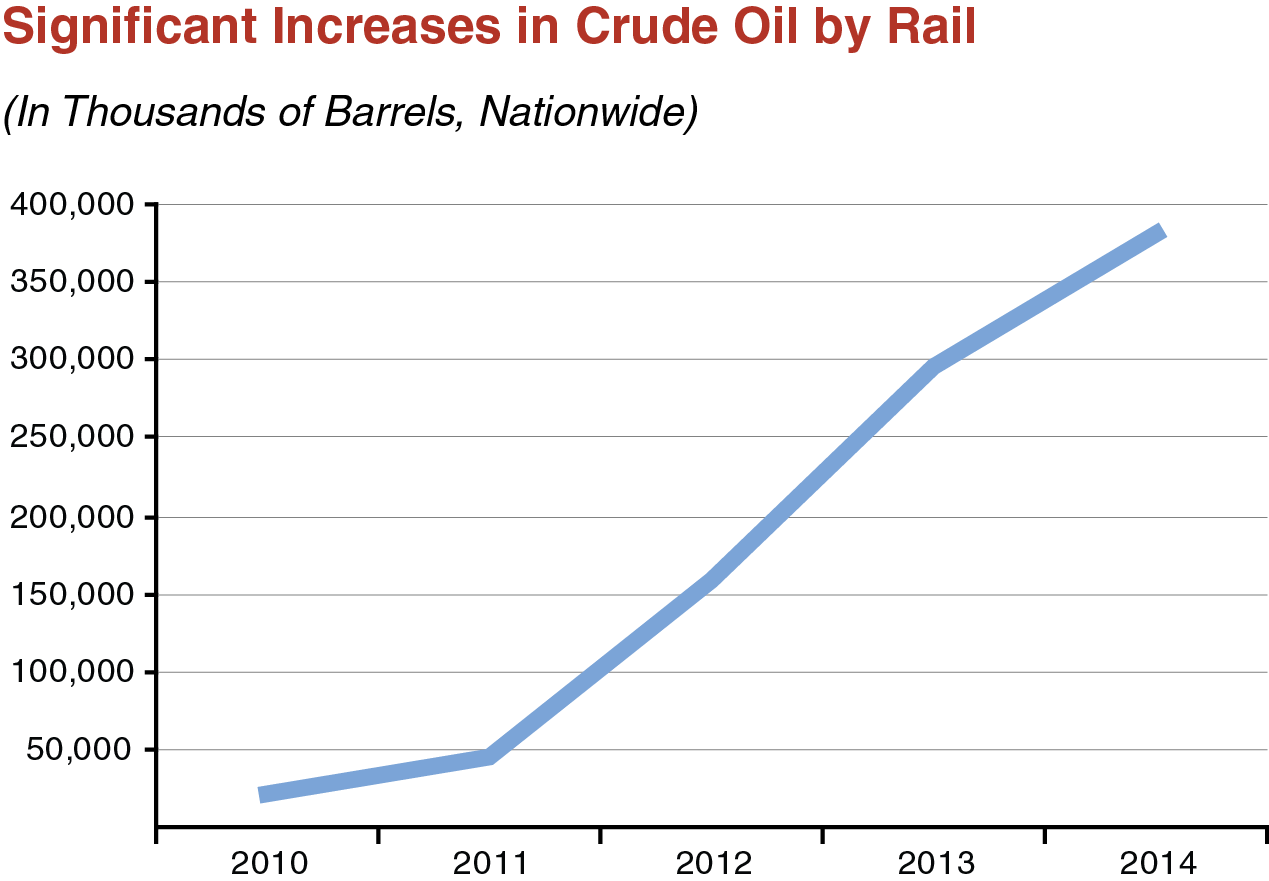LAO Contact: Brian Brown
December 17, 2015
Crude Oil by Rail—Federal Update
On December 4th, President Obama signed into law a long-awaited federal transportation funding reauthorization bill—the Fixing America’s Surface Transportation (FAST) Act—which provided $305 billion over five years for the nation’s transportation systems. The purpose of this report is to inform California lawmakers about additional provisions of the bill designed to address safety concerns around the transportation of crude oil by rail.
Nationwide Safety Concerns Following Derailments. In recent years, there have been multiple high-profile derailments of trains pulling crude oil. These accidents have resulted in deaths, evacuations, property damage, and oil spills. Most tragically, a derailment in Lac Megantic, Quebec in 2013 resulted in 47 deaths and spilled 1.5 million barrels of oil. Consequently, there have been concerns around the country, particularly as the production of crude oil in North America and its shipment by rail have increased substantially in recent years.

Federal Law Preempts State Action in Most Cases. The Federal Railroad Administration and the Pipeline and Hazardous Materials Safety Administration—both within the federal Department of Transportation (DOT)—are the primary agencies responsible for regulating the rail industry and the transportation of crude oil. Under federal law, states are limited in their authority to regulate rail activity. For example, the federal government regulates tanker design standards and the use of safety technologies. State and local agencies generally have responsibilities for emergency response. (The National Conference of State Legislatures website and our analysis of a 2015-16 budget proposal for the Office of Emergency Services [OES] have more information on federal and state oil by rail programs and policies.)
Federal Transportation Funding Bill Included Crude by Rail Policy Changes. While most of the 1,300 FAST Act focuses on various federal transportation funding programs to state and local governments, there are several provisions designed to address the safety of transporting crude oil by rail. Specifically, the bill requires:
- Safer Tanker Cars. The bill requires that over the next several years all tanker cars carrying crude oil (or other flammable liquids) meet “DOT 117” specifications, which are designed to meet higher safety standards in the case of an accident. This law expands on a May 2015 regulation adopted by DOT which required that all trains with at least 20 consecutive (or 35 total) tankers carrying crude oil (or other flammable liquids) utilize new or retrofitted tank cars meeting the DOT 117 design standards.
- Installation of Thermal Blankets. All new and retrofitted tanker cars meeting the DOT 117 specifications will be have to be equipped with “thermal blankets”—insulation technology designed to improve safety by better containing fires.
- Increased Reporting. By the end of 2016, DOT must issue regulations requiring railroads to provide state emergency response officials with information regarding the transport of hazardous materials, including information on the type and quantity of materials, the train’s point of origin and destination, and emergency contacts. This builds on DOT emergency regulations from 2014 that required railroad carriers to report to state emergency response officials regarding train transports of Bakken crude oil of at least 1 million gallons.
Recent State Budgets Added Funding for Some Crude by Rail Safety Activities. The Legislature and Governor have adopted some policy and funding increases designed to improve public safety associated with crude oil by rail in recent years.
- Oil Spill Prevention and Response. The 2014-15 budget included $8.7 million from the Oil Spill Prevention Administrative Fund to expand the Department of Fish and Wildlife’s oil spill prevention and response activities to include the prevention of inland spills. (Previously, the department’s authority was limited to preventing marine spills and responding to both marine and inland spills.) The budget package expanded an existing fee on oil brought into California over marine waters to all oil delivered to California refineries.
- Local Emergency Response. The 2014-15 and 2015-16 budgets each included $10 million loans from the High–Cost Fund–B Administrative Committee Fund to the Regional Railroad Accident Prevention and Immediate Response Fund. These loans were intended to allow OES to purchase hazardous material response vehicles and training for local hazardous material response teams. These teams will be required to respond to rail hazardous material accidents at the direction of OES. The 2015-16 budget package also established a fee on the top 25 most hazardous materials travelling by rail in California (as defined by OES). Fee revenue will be used to repay the loans and provide ongoing funding for the program. The legislation also required OES to periodically reassess rail hazardous response needs across the state, the appropriateness of the fee amount, and the effectiveness and efficiency of the state’s new activities.
- Rail Bridge Inspections. The 2014-15 budget included an increase of $1.1 million for the Public Utilities Commission to conduct inspections of rail bridges, as well as other related activities.
Issues for Legislative Oversight. Given recent public interest in the safety of transporting oil shipments by rail in California, the Legislature may want to review the degree to which the new federal policy changes—in conjunction with recent state spending—address its safety concerns. This review could occur in the course of normal budget and policy hearings and include the presentation of testimony and data from state, federal, and local officials regarding:
- How state funding provided in recent years to improve public safety associated with crude by rail has been utilized to date.
- The extent to which state funding and new federal policies will improve public safety.
- What safety issues remain un- or under-addressed.
- The potential for state or local entities to fill public safety gaps still remaining.
